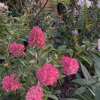black tipped leaves on hydrangea
irishoney
16 years ago
Related Stories

GARDENING GUIDESWhat's Wrong With My Plant? Leaves Often Hold the Clues
Learn how to identify common plant ailments by reading their leaves
Full Story
FALL GARDENING5 Ways to Put Fall Leaves to Work in Your Garden
Improve your soil and yard the organic way with a valuable garden booster that grows on trees
Full Story
GARDENING GUIDES10 Tips to Start a Garden — Can-Do Ideas for Beginners
Green up your landscape even if you're short on time, money and knowledge, with these manageable steps for first-time gardeners
Full Story
LIFETips for Moving Into a Smaller Space
Downsize with less compromise: Celebrate the positive, pare down thoughtfully and get the most from your new home
Full Story
FARM YOUR YARDHow to Grow Vegetables in Containers
Get glorious vegetables and fruits on your patio with a pro’s guidance — including his personal recipe for potting mix
Full Story
MOST POPULAR33 Magic Household Cleaning Tips
Houzzers from around the world share their tips for transforming housework into child’s play
Full Story
HOLIDAYSChristmas Cleanup Tips for the Not Naturally Organized
Dreading the postholiday chores? First let yourself unwind. Then grab some boxes, a few supplies and this easy guide
Full Story
MOVINGRelocating Help: 8 Tips for a Happier Long-Distance Move
Trash bags, houseplants and a good cry all have their role when it comes to this major life change
Full Story
MEDIA ROOMS5 Tips to Turn Your Basement into a Media Room
From wiring to gadgets to decor, a designer tips us off to the secrets for media room success
Full Story
MOST POPULARContractor Tips: Top 10 Home Remodeling Don'ts
Help your home renovation go smoothly and stay on budget with this wise advice from a pro
Full StoryMore Discussions








luis_pr
stephen9
Related Professionals
Wrentham Landscape Architects & Landscape Designers · Brentwood Landscape Architects & Landscape Designers · Folsom Landscape Architects & Landscape Designers · Brookfield Landscape Contractors · Garland Landscape Contractors · Mastic Beach Landscape Contractors · Maywood Landscape Contractors · Milford Landscape Contractors · North Richland Hills Landscape Contractors · Vermilion Landscape Contractors · Wallingford Landscape Contractors · Hueytown Landscape Contractors · Four Corners Siding & Exteriors · Rochester Siding & Exteriors · Saint Petersburg Siding & Exteriorsluis_pr
stephen9
luis_pr
lesfalc